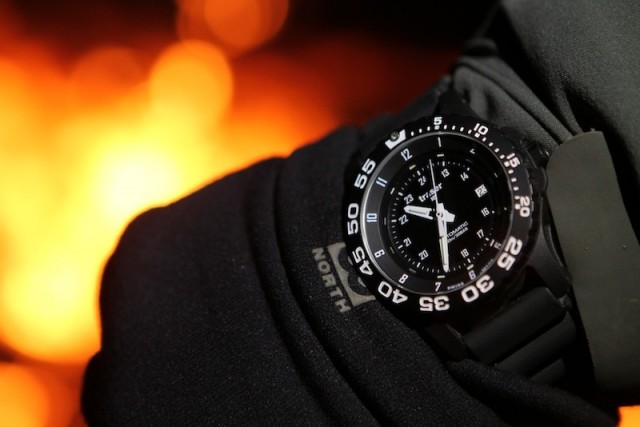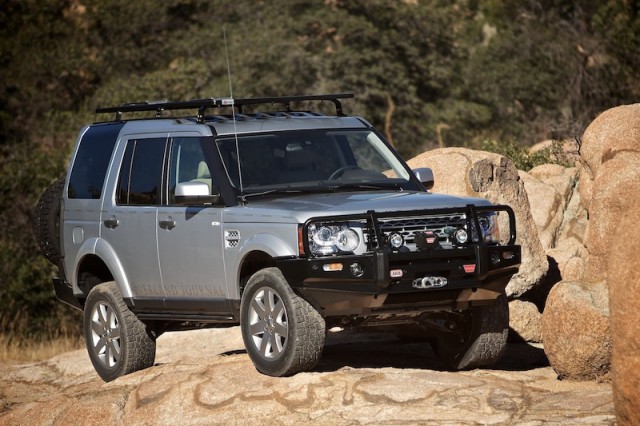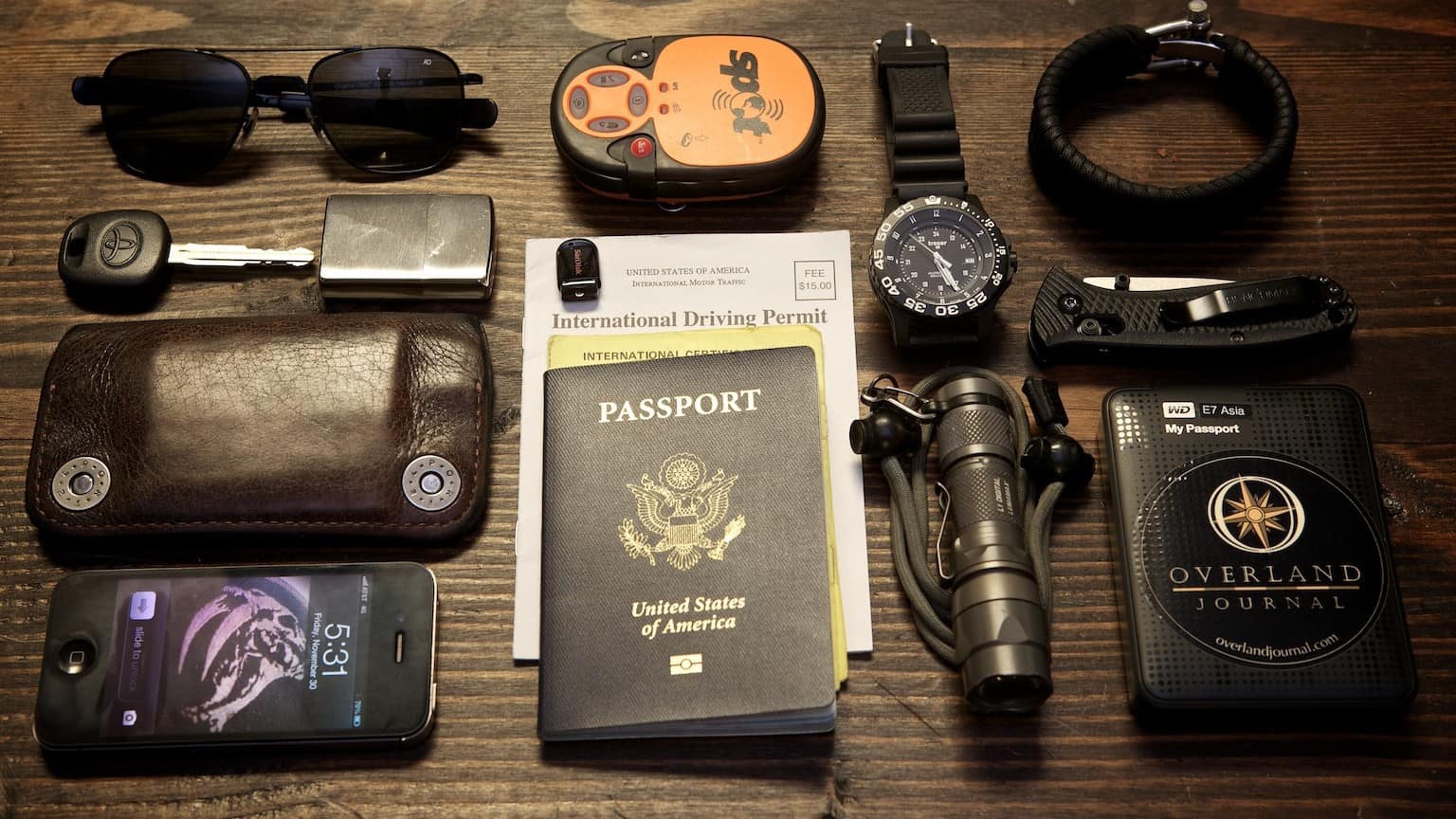With seven continents, 130+ countries and over 300 years of combined overland travel experience, our team has learned a few things about what equipment really works and how best to pack and organize all that gear. We will review best practice for everything from personal equipment to the contents of your recovery kit, and everything in between. We will always favor quality over price, but every effort will be made to identify proven value options as well.
Personal Carry:
The items we carry on our person should reflect the realities of the environment we are operating in, striking the balance between “gear-geek” and the cellphone/knife baseline. As a traveler, it is impossible to prepare for every eventuality, so a compromise must be struck to afford solutions for common or life threatening problems. We will also reiterate the mantra that training and practice with a few key tools are more effective in the real world than a pile of shiny gear. So, what are the basics we are attempting to achieve with the equipment we carry?

The author in Siberia and the Road of Bones, Russia
- Communications: Without question, hundreds of challenges facing the traveler can be solved with an iPhone, from serving as a decent LED light to finding our way through the crooked streets of Samarkand. We can call for help or arrange a reservation overlooking the canals of Venice. A smartphone with a world date/voice/text plan is worth its weight in gold. However, the one serious challenge with any smartphone is the limited battery life and dependency on the cellular network. As a result, we should have a secondary means of communications available, preferably satellite-based. This is where a personal locator beacon like a SPOT proves effective. These devices can provide real-time tracking, communicate the need for basic support (non-life-threatening) or call for the cavalry (life-threatening). With extensive training, survivalists can live in most environments, sometime indefinitely, but the average traveler needs outside support- quickly.
- Shelter: To dispel any delusions, you can leave that worthless aluminized space blanket on the rack at Walmart. I will also admit that personal vanity eliminates any possibility I will walk around with a fanny pack filled with endless survivalista. As a result, shelter is what you are wearing or what you can find/build. We will review clothing in detail with the next article, but the clothing you are wearing should be appropriate to the environment you are operating in. Keep the cab of the vehicle cool and stay layered-up in cold climates. Always wear footwear suitable to a vehicle recovery, which makes them suitable for walking through the woods for miles too. The best example of this is an adventure motorcyclist. They are already wearing robust, all-weather gear and boots ready for some serious climates and abuse. Don’t let the climate control and heated leather seats get you in serious trouble.
- Tools: Tools are likely where my opinion and those of others are deviate. I prefer to carry a high-quality folding knife with at least 40% of the blade’s length being serrated. The alternative would be to carry a multi-tool, as those devices have multiple functions. For me, the knife is the tool I want, and I want it available immediately, and in one fluid, rapid motion. You may need a nail file or Philips screwdriver – I just want a really sharp knife. Additional tools that I carry for travel include a lighter and a paracord bracelet. The bracelet gives 25’ of 500lb. breaking-strength cord, great for building shelter, securing a splint or any other innumerable solution. Be sure to buy one with the metal clasp, not the plastic clips. For a lighter, I have tried just about all of them and have ultimately settled on the Zippo, made in the USA and infinitely serviceable and refillable. I tried an $80 Helios lighter that never seemed to work when I needed it and nearly killed me during a winter ascent, as it refused to light above 12,000’.
- Note: Be sure to check local laws for the carry knife. Some cities may have length limitations (usually 3”) or rules against knives altogether.
- Flashlight: I carry a flashlight on a lanyard around my neck 24-hours a day while traveling. For me, experience has made this a necessity, not an option. A high-power LED light (100+ lumens) with a low-watt function for extended use and a crenelated bezel for getting someones attention.
- Timepiece: I like to wear an analog watch, preferably an automatic. Sure, you can buy a watch that will tell you heart rate and air temperature, but most of those features are pretty irrelevant in real use and it makes the device heavily dependent on batteries. I remember two travel companions tossing their expensive and feature-rich watches in the trash somewhere in Nicaragua, the batteries dying less than six weeks after purchase. Another strong consideration for a nice, analog watch is the “wearable currency” argument. This is especially true of the well-known brands like Rolex. A very expensive but ultimately effective “get out of jail free card”. . .
- Data: As a traveller, we have documents and backups we need to maintain for critical information. In the basic form, a small thumb drive with jpeg and pdf scans of all your travel documents is important if any originals are stolen. I keep a scan of every page of my passport, including all current and past visas. I also keep scans of my shot record, international driver’s license, Arizona driver’s license, all vehicle documents and even copies of vehicle service manuals. Even with a 4GB drive, there will still be room left for high-resolution jpegs of your favorite images from the trip as a backup. Each night, I back-up all of my images and video to three redundant drives and then rank my best images. I then copy the highest ranked images over to the thumb drive. This may seem like a bunch of extra work, and it is, but as a photographer, the thought of my images being lost forever justifies the effort. Keep the thumb drive separate from your wallet/purse or passport holder. For international trips, I keep a pocket drive on my person in addition to the thumb drive. The pocket drive contains a complete copy of all the images and video from my trip. The pocket drives are small enough to slip into a front or side pocket. It will only be a matter of time until solid state drive have enough capacity to serve the function, but be even more compact and robust.
- Documents: Particularly when traveling internationally, all of your important documents like passport, etc. should be kept on your person, but separate from your valuables and cash. I keep my passport, international driver’s license and shot record all in a hidden pocket and in my first layer of clothing. Those documents should be in a passport holder around the neck, in a zipper pocket in your shirt or in a hidden pocket in your pants. I also prefer to keep them in a ziplock bag. Never store document like these in a removable layer like a jacket, as those garments can easily be left on accident or stolen. When shopping for clothing, find garments that have these hidden pockets as these offer better security that a passport holder or money belt. It is pretty easy to replace cash and credit cards, but good luck getting a quick turnaround on a Tajikistan visa.

A Note About Product Quality:
Product quality, durability and reliability are primary considerations for equipment selection as an adventure traveler. This emphasis is born from necessity, as much of the equipment we use serves to ensure the safety, health and comfort of the overlander. If a cheap lighter or headlamp stops working at the nearest campground, the failure will only be an inconvenience. If a lighter fails in Siberia or a headlamp shorts-out while scouting a remote jungle track in Guatemala, the consequences can be far more serious. Buy once – buy quality. It is also noteworthy that our equipment selections also trend towards the originators, not imitators- the craftsman, not copycats.
International Carry Checklist

My personal international carry equipment. Well used and loved. CLICK FOR FULL SIZE IMAGE
International Carry Checklist:
These are the items I carry on my person every day when I am traveling internationally. This list has served me well from the jungles of Central America to the Wakhan Corridor of Central Asia. In reality, there are 1,000 variations to this theme and ultimately the traveler needs to carry items they feel are important. For example, many travelers would have a point-and-shoot camera in this pile. I am either shooting with a 5D MKIII or my iPhone – not much in between.
- 1. Sunglasses:
- 2. 70 Series Land Cruiser key: The most reliable and robust overland vehicle ever made. Current serving as our RTW platform for Expeditions 7.
VDJ78 Land Cruiser for Expeditions 7
- 3. Zippo Lighter: Simple, serviceable and only $20.
- 4. Portel Wallet: Holds a few credit cards, the day’s cash requirements, and protects my iPhone. Made by craftsman in Estonia.
- 5. iPhone: One of the most useful travel tools ever invented.
- 6. SPOT Locator: Leave the tracking running and change the batteries every few days.
- 7. SanDisk 4GB Thumb Drive: The size of a nickel and holds digital copies of all important documents. (available up to 32gb)
- 8. International Driving Permit:
- 9. International Immunization Certificate (ICV): Shot record / yellow card
- 10. Passport: Keep it on your person almost 24 hours a day
- 11. Traser H3 Watch: Waterproof, excellent night illumination and no batteries
- 12. SureFire LED Flashlight: 100+ lumens, a crenelated bezel and lanyard
- 13. Paracord Bracelet: 25 feet of cord and a metal clasp
- 14. Knife (folder): Buy quality and keep the blade length under 3”
- 15. Pocket HDD: (optional) Keep copies of all images and video
Western Digital My Passport [link]
One of the VDJ78 Land Cruisers used on Expeditions 7

Domestic Carry Checklist (USA)

My personal domestic overland kit CLICK FOR FULL SIZE IMAGE
Domestic Carry Checklist:
For local travel, requirement change only slightly, but are worth review and consideration.
- 1. Sunglasses:
- 2. Discovery 4 (LR4) key: Land Rovers have been my primary domestic travel choice for decades. The breadth of capability is well suited to North American exploration.
LR4 Overland Journal Project [link]
- 3. Zippo Lighter: Simple, serviceable and only $20.
- 4. Portel Wallet: Holds a few credit cards, the day’s cash requirements, and protects my iPhone. Made by craftsman in Estonia.
- 5. iPhone: One of the most useful travel tools ever invented.
- 6. Paracord Bracelet: 25 feet of cord and a metal clasp
- 7. SureFire LED Flashlight: 100+ lumens, a crenelated bezel and lanyard
- 8. Traser H3 Watch: Waterproof, excellent night illumination and no batteries
- 9. Knife (folder): Buy quality
- 10. SPOT Locator: Leave the tracking running and change the batteries every few days.
- 11. SanDisk 4GB Thumb Drive: The size of a nickel and holds digital copies of all important documents, and back-ups of favorite images.
- 12. M1911A1 .45 ACP Pistol: This particular 1911 served my family in WWII and was produced in low volume in support of the war effort by the Union Switch & Signal Company.
History of the 1911 .45 [link]
Note: While personal security equipment and features are mentioned in this article, it is beyond the scope of this editorial to delve into the requisite practicum. Knives, crenelated blunt weapons and firearms are all subject to restrictions and laws depending on where you travel.

My current project, a 2012 Land Rover LR4. Well suited to travel in the desert southwest.


